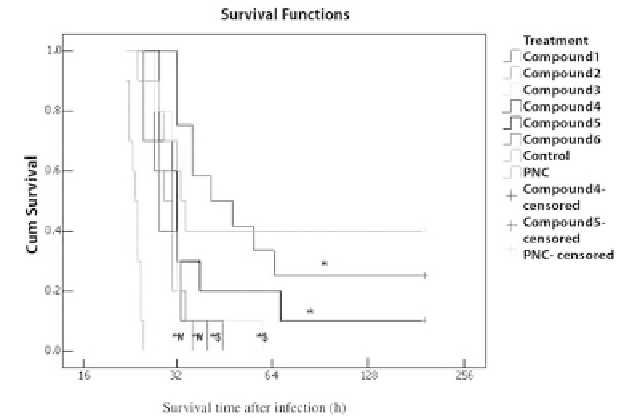Biology Reference
In-Depth Information
Therapeutic Effects of the Lead Compounds in Mouse
S.
pneumoniae
Infections
Mouse sepsis models by
S. pneumoniae
(ATCC7466) were successfully established by
intraperitoneal injection of 100 μl
S. pneumoniae
(5 × 10
3
CFU/ml). Generally, these
mice began to die within 24 hr and could not survive more than 48 hr unless they got
appropriate therapeutic treatments. For facilitation of comparisons between the effects
of these compounds and positive control (penicillin), the concentration of penicillin
used in this study almost equaled to that of the lead compounds. To rule out the di-
rect antibacterial effects that may compromise with the efficiency of this model, the
lead compounds and penicillin were administrated through caudal vein. As shown in
Figure 7, these compounds were able to decrease, though slightly, the mortality of the
infected mice in the first 24 hr as compared to negative control (normal sodium, NS)
(
p
< 0.01). Significant treatment effects were found among the groups (
p
< 0.01) by
an overall comparison. Pairwise comparisons revealed that compounds 1-6 prolonged
survival time in mouse sepsis models as compared to negative control (p < 0.01).
However, compound 1, 2, 3, and 6 were less effective than positive control PNC (
p
<
0.05 or
p
< 0.1). Although, these compounds could not reverse the fatal pneumococcal
infection with concentration used in this study,
in vivo
antibacterial activity of these
six compounds suggested that it would be promising to develop lead-compound-based
drugs against pneumococcal infection.
Figure 7.
Therapeutic efficacies of each lead compound against infection with
S. pneumoniae
ATCC7466 in mice. Figure shows the cumulative survival (survival probability) of the mouse
infection models treated differently in the following 8 days (survival time more than 8 days was
censored). Data were analyzed by using the survival analysis approach (Kaplan-Meier Method).
Significant treatment effects were found among the groups (P < 0.01) by an overall comparison.
Pairwise comparisons revealed that compounds 1-6 prolonged survival time in mouse infection
models as compared to negative control (
p
< 0.01), and that compound 4 and 5 were almost as
effective as positive control PNC (P > 0.1), but the other compounds were less effective than it (P <
0.05 or P < 0.1). *P < 0.01 indicates significant differences as compared to negative control; #P <
0.05 and $P < 0.1 indicate significant differences as compared to positive control.

















